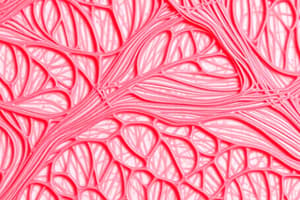Podcast
Questions and Answers
Which type of muscle tissue is characterized by striations?
Which type of muscle tissue is characterized by striations?
- Smooth muscle
- Both cardiac and skeletal muscle (correct)
- Skeletal muscle
- Cardiac muscle
A muscle cell is also known as a muscle fiber.
A muscle cell is also known as a muscle fiber.
True (A)
The connective tissue that surrounds an individual muscle fiber is called the ________.
The connective tissue that surrounds an individual muscle fiber is called the ________.
endomysium
What is the primary function of T-tubules in muscle contraction?
What is the primary function of T-tubules in muscle contraction?
Match the following connective tissue layers with their location in skeletal muscle:
Match the following connective tissue layers with their location in skeletal muscle:
Which of the following is NOT a role that muscles play in the body?
Which of the following is NOT a role that muscles play in the body?
Actin is the thick filament in the sarcomere.
Actin is the thick filament in the sarcomere.
What ion is essential for muscle contraction?
What ion is essential for muscle contraction?
Flashcards
Types of Muscle Tissue
Types of Muscle Tissue
Skeletal, smooth, and cardiac.
Connective Tissue Packaging
Connective Tissue Packaging
Connective tissue layers in skeletal muscle: endomysium (around each fiber), perimysium (around fascicles), and epimysium (around the entire muscle).
Muscle Tissue Hierarchy
Muscle Tissue Hierarchy
Arrangement from largest to smallest: Muscle, fascicle, fibers, myofibrils, myofilaments.
Roles of Muscles
Roles of Muscles
Signup and view all the flashcards
Sarcomere
Sarcomere
Signup and view all the flashcards
Actin Filaments
Actin Filaments
Signup and view all the flashcards
Motor Unit
Motor Unit
Signup and view all the flashcards
Sarcoplasmic Reticulum
Sarcoplasmic Reticulum
Signup and view all the flashcards
Study Notes
- There are three types of muscle tissue, each with defining characteristics related to their location, function, and whether they are striated.
- A muscle cell can also be called a muscle fiber.
- Connective tissue packaging surrounds skeletal muscle.
- The three types of connective tissue are endomysium, perimysium, and epimysium, each found in specific locations.
- The arrangement of skeletal muscle tissue terms in order is: Muscle, fascicle, fibers, myofibrils, and myofilaments.
- The striated appearance of skeletal muscle tissue is caused by specific factors.
- Muscles play four important roles in the body.
- A sarcomere is found between two Z lines.
- Actin is the thin myofilament, and myosin is the thick myofilament.
- Certain bands/zones on the sarcomere shorten during contraction.
- Actin is the thin filament and has binding sites for myosin cross-bridges, which are exposed under certain conditions.
- Myosin is the thick filament and possesses ATPase enzymatic capabilities to split ATP and has cross-bridge heads to grab and pull actin.
- A motor unit can be defined.
- Acetylcholine is relevant to muscle function.
- T-tubules and their role in muscle contraction should be understood.
- The sarcoplasmic reticulum should be studied thoroughly.
- Calcium's specific role in muscle contraction must be understood.
- Graded muscle contractions are produced in two ways.
- ATP is split via hydrolysis.
- There are three pathways of ATP regeneration.
- Explain the benefits of each ATP regeneration pathways.
- Differentiate between a muscle's origin and insertion.
- Recognize how muscles are named and how fascicles can be arranged differently.
Studying That Suits You
Use AI to generate personalized quizzes and flashcards to suit your learning preferences.




